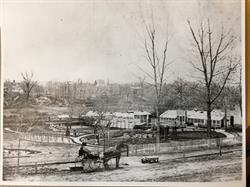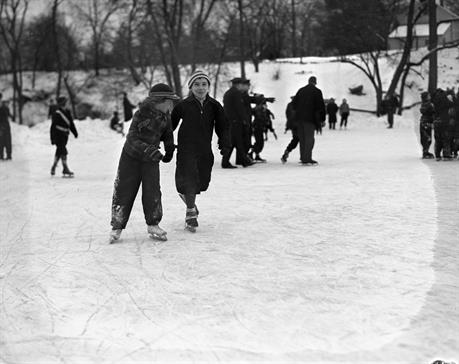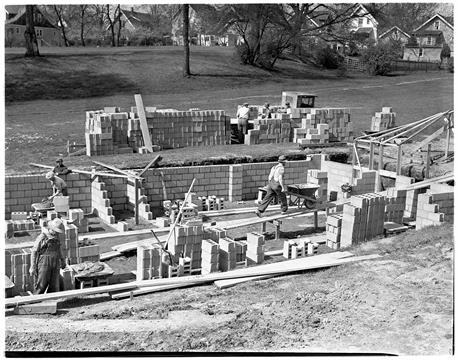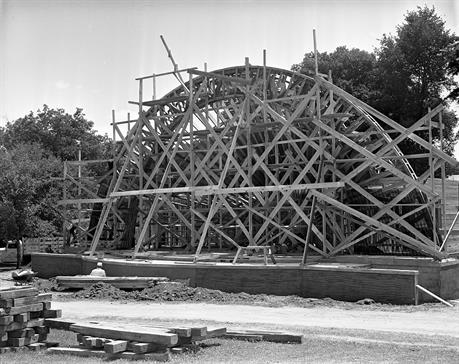The land that is now West Park has served as parkland just west of Ann Arbor's downtown since 1908. In the city's early days the land contained a stream where two branches from the west met and flowed east into Allen Creek. The Native peoples who inhabited the area or traveled through would have had other names for Allen Creek and the stream feeding into it.
The stream also played center stage in shaping the park. Early development occurred on the bluffs around it, not beside it. This left mostly open ground for grazing and watering horses, cows, and other domestic animals kept by residents on the bluffs. The stream was also used for watering plants at J. Toms' greenhouse and formal English gardens at Miller and Chapin streets. A Parks department news article on Toms' greenhouse in 1882, had the words "Future West Park in Background" accompanying this photograph.

An archeological survey found unremarkable historic, modern, and contemporary artifacts (like pieces of white ceramic dinner plates) in almost all areas of West Park. The land around the stream was likely used as a rubbish site. During 2009 construction activities part of a Model-T automobile with plates was found. The land may have been rescued by becoming parkland.
In the late 1920s the stream's waters were corralled to flow in drain pipe unseen underground. Part of the stream was brought back into the sunlight as West Park was transformed in 2009 into a stormwater management system. Bioswales, wetlands, and a pond were created to handle stormwater runoff increasingly flowing into the park from the stream's highly developed and paved watershed. The water system was also designed to clean the water the naturally with plants and slow filtering through the ground.
'West Park' came into being with the purchase in 1908 of four parcels of land totaling about 6 acres. With this land came frontage on Chapin Street. Only one house had to be moved to make it parkland. At first it was referred to as 'Westside Park' or 'West Side Park and Athletic Field.'
From this humble beginning, West Park grew in pieces – 28 pieces in total… a possible record for Ann Arbor parks! – to its current almost 27 acres. Acquisitions occurred over a hundred year period, 1908-2009. In addition to outright purchases, many ways were used to acquire the land. The first 6 acres were on land contract. The largest piece came from a park commissioner buying and holding the land until the city could afford to buy it. Land swaps with public schools also shaped West Park. Providing access to West Park has also been no small challenge. Lots have been obtained for frontage on a street. When no street frontage was available, a lot with a right of way to the street was obtained. When West Park-east and West Park-west were separated by private property, permission was obtained to use a railway right of way for a path through.
Visions of athletic fields danced in the heads of the park board and city alike when creating West Park. A 'West Park Time Line', a document in Parks Department files, summarizes developments in the park 1908-1995. Baseball and tennis were in play within two years of West Park coming into being.Two ball diamonds were constructed right away. Rules were posted and soon a bleacher was built. Within five years land was exchanged for more space behind the backstop. Many tennis courts were built in the early years of the park. One clay tennis court appeared in 1910, courts grew to three in total in 1914, five in total in 1928. The first paved tennis courts, two asphalt courts, entered the scene in 1965.
West Park has had a basketball court in one location or another for many years. When basketball was introduced in the park, however, is not clear. The Park Board was petitioned for a basketball court in 1910, but it was not approved. Curiously, no mention of a basketball court appears in the Park Department's West Park Time Line.
The first children's playground in West Park came into being in 1915. The public schools board was given permission to use part of West Park as a playground. The following year toilets with water tap were constructed in the park.
Sledding on the hills was probably a favorite winter activity long before the hills were officially within West Park boundaries. There is a suggestion in city records that the area where West Park was created used to be a skating rink. However, a local historian offered convincing evidence that the early skating rink was on the other side of Miller Avenue.
In the early 1930s an artificial lake was built in West Park for ice-skating in winter and wading in summer. The lake was a city relief project to help employ workers during the depths of the Great Depression. The lake lasted for about fifteen years, at which point it became a danger and was filled in. After that time, temporary ice rinks were formed in wintertime so ice-skating could continue in West Park. Wading pools appear to have been constructed as early as 1938 and 1944. These were difficult to maintain, given Ann Arbor winters and frequent freeze-thaw cycles. Over time wading pools, like the artificial lake, disappeared from West Park.

In 1925 when the now-historic entrance Pergola was erected on the northern bluff. The land there, grounds of the old 3rd Ward/Mack School, had been obtained in a land swap with public schools. The marble pillars used in the original structure likely were salvaged from a former building in the area. The Pergola was erected by the Superintendent of Parks, Eli Gallup, from plans made by a Mr. O'Dell.
Over the years West Park has been host to countless community activities. The park has experienced pageants with various themes sometimes with attendance as high as 2,500 people. Events that have happened at West Park include school picnics, state championship cross-county races, and Interfaith Council for Peace events.
West Park has also been the venue for a great number of music and theatre performances. In response to this, an open air concert shell was built. The shell received funding from the WPA (Works Progress Association), a New Deal program to help provide jobs during the
Great Depression and lift spirits. Over time the shell got the name 'Band Shell.' It has served as a focal point for community and charitable events.
The Band Shell became a part of the park in 1938, roughly a decade after the Pergola. A home-grown structure designed by the Department of Public Works with Bernard DeVries as Public Works Department architect. The Band Shell project was supervised by the City Engineer. Like the Pergola, the Band Shell was listed on Ann Arbor's Register of Historic Places in 1995.


A Silver Star Award project sets you traveling a brief history of the Band Shell and options for its future. A deeper plunge into times and events allows further exploring of the Band Shell's historical terrain.
The Band Shell is a multi-purpose structure serving as a venue for both entertainment and community service events. The West Park Shelter, built thirty years after the Band Shell, was a multi-purpose structure for sports and community events. Shelters in West Park have come and gone. The early ones seem to have served mostly as warming areas for winter sports. The most recent shelter, however, was designed for both summer and winter use. It was also intended for community meetings and for voting purposes. With Robert C. Metcalf as architect, the shelter followed a design with both open and enclosed parts.
The eventual demise of the West Park Shelter seems more related to social ills than to structural problems. By the 1980s social conditions across the nation were getting worse. Homelessness, drugs and alcohol and a lack of support for mental healthcare were all taking a toll on West Park Shelter. Around 1980 the shelter's exterior benches were removed and its outdoor fireplace was covered. Social ills continued into the 1990s, and the shelter continued to attract problem behaviors. At some point, most likely in the mid to late 1990s, the West Park Shelter was torn down.
Renovation of West Park in 2010/11 followed on the 2009 stormwater project that transformed water flow in West Park. Concrete retention walls for seating at the Band Shell were added to the hill facing it. A piece of public art, TREEform, was added as a feature in the Band Shell's seating area. The historic Native American trail was given better attention. The basketball court was moved out of the floodplain. Project Grow gardens were added. The network of paths was rebuilt, adding a boardwalk along the pond. Damaged stairways going into the park from Huron Street were replaced. Numerous black willow saplings --offshoots of earlier large, elder trees-- were planted and now (in 2022) rise 30 feet or more. The renovation project together with the stormwater management project revitalized the park. Memories of those projects and more offer interesting insights into West Park.
West Park has come full circle, back to its early beginnings as a park with water flowing. As restorative openings for the stream and stormwater management have returned, wildlife appeared as if by magic. Birds, muskrats, fish, turtles, frogs, salamanders, bees, butterflies, dragon flies, all abound. The sights and sounds of redwing blackbirds and robins –signs of Spring-- now appear in a riot of song. Raptors such as Red-tailed Hawk, Cooper's Hawk, and Merlin can be seen hunting from the park's tall trees. Trees that have offered shade for hundreds of years, calming water and the spirit of Nature are all right here. West Park offers hints of what early Native peoples and Euro-American settlers once experienced here. The beauty of nature is right there at the edge of Ann Arbor's bustling downtown.
